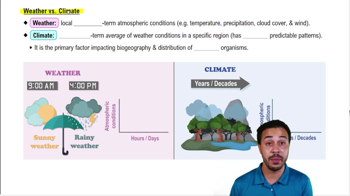Table of contents
- 1. Introduction to Biology2h 40m
- 2. Chemistry3h 40m
- 3. Water1h 26m
- 4. Biomolecules2h 23m
- 5. Cell Components2h 26m
- 6. The Membrane2h 31m
- 7. Energy and Metabolism2h 0m
- 8. Respiration2h 40m
- 9. Photosynthesis2h 49m
- 10. Cell Signaling59m
- 11. Cell Division2h 47m
- 12. Meiosis2h 0m
- 13. Mendelian Genetics4h 41m
- Introduction to Mendel's Experiments7m
- Genotype vs. Phenotype17m
- Punnett Squares13m
- Mendel's Experiments26m
- Mendel's Laws18m
- Monohybrid Crosses16m
- Test Crosses14m
- Dihybrid Crosses20m
- Punnett Square Probability26m
- Incomplete Dominance vs. Codominance20m
- Epistasis7m
- Non-Mendelian Genetics12m
- Pedigrees6m
- Autosomal Inheritance21m
- Sex-Linked Inheritance43m
- X-Inactivation9m
- 14. DNA Synthesis2h 27m
- 15. Gene Expression3h 20m
- 16. Regulation of Expression3h 31m
- Introduction to Regulation of Gene Expression13m
- Prokaryotic Gene Regulation via Operons27m
- The Lac Operon21m
- Glucose's Impact on Lac Operon25m
- The Trp Operon20m
- Review of the Lac Operon & Trp Operon11m
- Introduction to Eukaryotic Gene Regulation9m
- Eukaryotic Chromatin Modifications16m
- Eukaryotic Transcriptional Control22m
- Eukaryotic Post-Transcriptional Regulation28m
- Eukaryotic Post-Translational Regulation13m
- 17. Viruses37m
- 18. Biotechnology2h 58m
- 19. Genomics17m
- 20. Development1h 5m
- 21. Evolution3h 1m
- 22. Evolution of Populations3h 52m
- 23. Speciation1h 37m
- 24. History of Life on Earth2h 6m
- 25. Phylogeny2h 31m
- 26. Prokaryotes4h 59m
- 27. Protists1h 12m
- 28. Plants1h 22m
- 29. Fungi36m
- 30. Overview of Animals34m
- 31. Invertebrates1h 2m
- 32. Vertebrates50m
- 33. Plant Anatomy1h 3m
- 34. Vascular Plant Transport2m
- 35. Soil37m
- 36. Plant Reproduction47m
- 37. Plant Sensation and Response1h 9m
- 38. Animal Form and Function1h 19m
- 39. Digestive System10m
- 40. Circulatory System1h 57m
- 41. Immune System1h 12m
- 42. Osmoregulation and Excretion50m
- 43. Endocrine System4m
- 44. Animal Reproduction2m
- 45. Nervous System55m
- 46. Sensory Systems46m
- 47. Muscle Systems23m
- 48. Ecology3h 11m
- Introduction to Ecology20m
- Biogeography14m
- Earth's Climate Patterns50m
- Introduction to Terrestrial Biomes10m
- Terrestrial Biomes: Near Equator13m
- Terrestrial Biomes: Temperate Regions10m
- Terrestrial Biomes: Northern Regions15m
- Introduction to Aquatic Biomes27m
- Freshwater Aquatic Biomes14m
- Marine Aquatic Biomes13m
- 49. Animal Behavior28m
- 50. Population Ecology3h 41m
- Introduction to Population Ecology28m
- Population Sampling Methods23m
- Life History12m
- Population Demography17m
- Factors Limiting Population Growth14m
- Introduction to Population Growth Models22m
- Linear Population Growth6m
- Exponential Population Growth29m
- Logistic Population Growth32m
- r/K Selection10m
- The Human Population22m
- 51. Community Ecology2h 46m
- Introduction to Community Ecology2m
- Introduction to Community Interactions9m
- Community Interactions: Competition (-/-)38m
- Community Interactions: Exploitation (+/-)23m
- Community Interactions: Mutualism (+/+) & Commensalism (+/0)9m
- Community Structure35m
- Community Dynamics26m
- Geographic Impact on Communities21m
- 52. Ecosystems2h 36m
- 53. Conservation Biology24m
48. Ecology
Introduction to Ecology
Problem 15a
Textbook Question
Tropical rain forests are the most diverse biomes. What factors contribute to this diversity?
 Verified step by step guidance
Verified step by step guidance1
Identify the unique climatic conditions of tropical rainforests, such as high temperatures and significant rainfall, which create a stable environment that supports a wide variety of life forms.
Consider the structural complexity of the rainforest, with multiple layers like the canopy, understory, and forest floor, each providing different habitats and niches for various species.
Explore the role of high productivity in tropical rainforests, where abundant sunlight and moisture support rapid plant growth, leading to a rich supply of food and resources for a diverse range of organisms.
Discuss the evolutionary aspect, where the long-term climatic stability of tropical rainforests has allowed species to evolve and diversify over millions of years without major disruptions.
Examine the concept of interdependence among species in the rainforest ecosystem, where complex relationships such as symbiosis, predation, and competition further drive speciation and diversity.
Recommended similar problem, with video answer:
 Verified Solution
Verified SolutionThis video solution was recommended by our tutors as helpful for the problem above
Video duration:
1mPlay a video:
Was this helpful?
Key Concepts
Here are the essential concepts you must grasp in order to answer the question correctly.
Biodiversity
Biodiversity refers to the variety of life forms within a given ecosystem, including the diversity of species, genetic variations, and ecological processes. In tropical rain forests, high biodiversity is a result of complex interactions among species and their environments, which allows for a multitude of niches and adaptations. This richness supports a wide range of organisms, from plants to animals, contributing to the overall health and resilience of the ecosystem.
Recommended video:
Guided course

Biodiversity and Sustainability
Climate and Weather Patterns
Tropical rain forests are characterized by warm temperatures and high levels of precipitation throughout the year. This stable climate creates ideal conditions for plant growth, leading to dense vegetation and a variety of habitats. The consistent moisture and warmth allow for year-round reproduction and growth, which fosters a rich array of species and ecological interactions.
Recommended video:
Guided course

Weather vs. Climate
Ecological Interactions
Ecological interactions, such as predation, competition, and symbiosis, play a crucial role in maintaining the diversity of tropical rain forests. These interactions help to shape community structures and influence species distributions. For example, mutualistic relationships between plants and pollinators or between fungi and tree roots enhance nutrient cycling and plant reproduction, further contributing to the biome's complexity and diversity.
Recommended video:
Guided course

Interspecific Interactions

 2:54m
2:54mWatch next
Master What is Ecology? with a bite sized video explanation from Jason Amores Sumpter
Start learningRelated Videos
Related Practice































































































